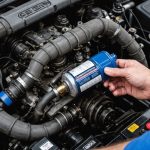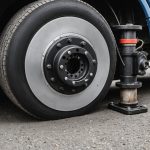Overview of Air Suspension Systems
An air suspension system is a type of vehicle suspension powered by an air pump or compressor. The air pump inflates rubber or plastic bellows, known as air springs, which lift the chassis from the axle, providing a smoother ride. This system can be automatically or manually adjusted to regulate the height and comfort of the vehicle.
There are several benefits of air suspension, particularly for show cars, where aesthetics and ride quality are paramount. Air suspension allows for adjustable ride height, giving the vehicle a lowered stance when parked and a higher profile when driving, enhancing both appearance and functionality. This flexibility can improve handling, reduce the risk of bottoming out, and adapt to various driving conditions.
Also to read : Ultimate Guide to Installing and Tuning Performance Chips in UK-Spec Cars
Air suspension systems come in different types, each with unique features. Electronically controlled air suspension systems offer convenience by adjusting the pressure automatically based on speed or road conditions. Another type is the manually adjustable system, where the driver can set the suspension’s height according to their preference. This adaptability is especially beneficial for vehicles used in different environments, ensuring optimal performance. Additionally, hybrid systems combine air springs with traditional suspension components for a balanced approach to comfort and handling.
Tools and Materials Required for Installation
When embarking on an air suspension installation, having the right tools and materials is crucial to ensuring a smooth process.
In parallel : Step-by-Step Guide: Installing an Aftermarket Sunroof in Your UK Car
Essential Tools for Installation
To start, a comprehensive set of tools for air suspension installation is necessary. This includes wrenches, socket sets, pliers, and a torque wrench to secure all components properly. Additionally, an airline cutter is indispensable for clean cuts of delicate tubing. These tools guarantee precision, reducing the risk of damage to the components.
Types of Materials Needed
The materials involved are also essential, playing a pivotal role in a successful installation. The shopping list should include air springs, compressor kits, and airlines. Having the correct diameters and specifications for each material ensures that every piece fits perfectly and functions as intended.
Recommended Brands and Purchasing Tips
Opting for quality brands ensures reliability and longevity of the installation. Brands like Firestone and Air Lift are renowned for their durability and performance in the air suspension market. It’s advisable to make purchases from trusted suppliers, who can provide warranties and customer support. This adds a layer of assurance, helping prevent potential pitfalls in the installation. By assembling the right tools and materials, your installation process will be more efficient and successful.
Safety Precautions During Installation
Taking the right safety precautions during installation is crucial to ensure both personal and vehicle safety. Prior to starting any installation, it is essential to thoroughly inspect your work area. Ensure it is free from potential hazards, such as loose tools or slippery surfaces, which could result in accidents. A well-ventilated area is fundamental to prevent inhalation of fumes or dust. This measure is particularly important when dealing with chemicals or adhesives, as these can pose significant health risks if not properly managed.
Incorporating personal protective equipment (PPE) into your routine is another vital step. Essential items include safety goggles to protect your eyes from debris, gloves to prevent skin irritation or cuts, and wearing a dust mask if there is a risk of inhaling particles. These precautions not only safeguard your health but also allow you to carry out the installation more efficiently by minimizing potential distractions or injuries.
Additional vehicle safety measures should also be considered, such as ensuring the vehicle is stable and secured, particularly if the installation involves working underneath. By adhering to these tips, you create a safer environment, significantly reducing the risk of injury and ensuring a successful installation process.
Step-by-Step Installation Process
Before diving into the air suspension installation process, it is crucial to understand the steps involved. This guide will ensure you methodically approach each stage while installing air bags and suspension components.
Preparing the Vehicle
To begin, ensure your vehicle is parked on a flat surface and the ignition is switched off. Safety should be your priority. Start by loosening the lug nuts and lifting the vehicle using a hydraulic jack. Secure it with jack stands for stability. Remove the wheels to expose the existing suspension components. This preparation is vital as it forms the foundation for a smooth installation.
Removing Existing Suspension Components
Once you’ve safely accessed the suspension, proceed to remove existing suspension components. Carefully detach shock absorbers, coil springs, and related parts. Precision is key; keep all nuts and bolts organized for future procedures. Certain kits might include additional brackets or supports, so watch those as you disassemble to avoid any damage.
Installing the Air Suspension System
With the area clear, you can begin installing the new system. Firstly, position the air bags into place, ensuring each is aligned with its mount. Connect the air lines securely, taking care to avoid any pinches or kinks. Finally, affix any additional components and brackets, double-checking their security with the vehicle raised. Reattach the wheels and lower the vehicle, hearing the satisfying click of a job well done. Installation complete!
Product Recommendations for UK Show Cars
When it comes to UK car modifications, especially air suspension kits, selecting the right brand is crucial. The market offers a wide array of options, each with its unique features catering to different needs. To find the best air suspension kits, consider looking at top-tier brands known for quality and reliability.
Top Recommended Brands
For the best air suspension kits, notable names such as Air Lift Performance and Viair are highly recommended. These brands are praised for their advanced design and durability, ensuring that your show car boasts both superior performance and aesthetic appeal. They offer comprehensive air suspension system brands that tailor to a variety of vehicles and customization preferences.
Choosing the Right Air Suspension System
When selecting an air suspension system for your show car, focus on compatibility, ease of installation, and adjustability. Ensure the kit matches your vehicle’s make and model. Kits that allow for fine-tuning suspension settings to suit different driving conditions provide added versatility.
Product Warranties and Support Services
A key consideration is the warranty and support services. Brands offering extended warranties and robust customer support enhance peace of mind. This ensures that any issues encountered post-installation can be resolved quickly, keeping your vehicle roadworthy and competition-ready. Always verify the terms and conditions associated with product warranties before purchase.
Legal Considerations for Air Suspension Systems in the UK
Navigating the realm of vehicle modifications in the UK requires a keen understanding of local regulations. The UK car laws are stringent when it comes to modifications, especially with systems like air suspension.
In the UK, any adjustment to the vehicle’s framework or suspension is subject to legal requirements. One must adhere to guidelines ensuring the modifications do not impede the vehicle’s performance or safety on the road. Modifiers should consult the Vehicle Standards for a comprehensive list of what’s permissible.
Moreover, modified vehicles often need to go through a registration and approval process. This ensures all changes comply with the Construction and Use Regulations and pass the MOT test. Often, specialist garages or professionals certified in these modifications will offer advice and services to help ensure compliance.
Compliance with local vehicle regulations cannot be understated. Non-compliance may result in fines or the vehicle being deemed unroadworthy. Therefore, thorough research and collaboration with approved specialists are essential for any legal modifications. By understanding and adhering to the necessary legal requirements, vehicle owners can enjoy their custom rides without risking penalties.
Maintenance Tips for Air Suspension Systems
Regular maintenance of air suspension systems is critical for maintaining vehicle performance and comfort. To ensure longevity, regular maintenance checks must be performed. These checks involve inspecting the airbags, compressors, and valves for wear and tear. Even minor damages can escalate into major system failures if left unaddressed.
Common issues faced with air suspensions include leaks in the airbags, malfunctioning compressors, and faulty sensors. System troubleshooting can help identify the root cause, allowing for timely repairs. Begin by listening for abnormal noises such as hissing, which may indicate a leak. Visual inspections can also reveal visible cracks or degradation in the suspension components.
A recommended maintenance schedule should include an annual comprehensive check-up by a professional technician. This service interval ensures that any hidden issues are caught early. Additionally, do quarterly self-checks focusing on visible components and system pressure levels.
For drivers, adhering to these maintenance routines not only enhances comfort but also prevents costly repairs down the line. Understanding your air suspension’s specific requirements can further optimize its performance. Remember, proactive care is the key to a smooth, reliable ride.
Troubleshooting Common Installation Issues
Installing air suspension systems can occasionally present a few challenges. Successful installation relies on adeptly identifying and solving common problems that might arise. Understanding these issues helps maintain air pressure and system functionality efficiently.
One such common issue is incorrect air pressure calibration, which can cause uneven handling or ride height. Ensure your system’s pressure settings align with the manufacturer’s specifications. Checking for leaks in hoses and connections is essential, as even minor leaks can lead to significant performance loss over time.
Another frequent obstacle involves the proper alignment of suspension components. Misalignment can impact system functionality, causing discomfort during rides. Carefully follow the installation guides, and if necessary, refer back to schematics or diagrams to verify all parts align correctly.
Handling unexpected challenges during installation requires a proactive mindset. Have a checklist of essential tools and materials needed beforehand. This may include wrenches, air line cutters, torque specifications, and sealant tape. In case certain issues persist, refer to troubleshooting resources or seek professional assistance to ensure complete and proper setup.
By anticipating and addressing these complications, you can enhance the productivity of your air suspension system and ensure a smooth ride. Proper preparation can mitigate many typical installation issues, safeguarding your vehicle against common troubles.
Visual Aids and Resources
Navigating the intricacies of air suspension systems can be daunting without the right tools. Fortunately, a wealth of installation videos and diagrams are available to guide enthusiasts through the process. These visual aids provide step-by-step instructions, making complex installations easier to understand. Diagrams are particularly helpful in mapping out the components and connections, ensuring each element is correctly positioned.
For those seeking more comprehensive support, supplementary resources online are invaluable. Websites dedicated to automotive repairs often host a variety of materials tailored to different skill levels. These resources range from basic guides to in-depth tutorials, ensuring both novices and experienced users can find what they need.
Engaging with community forums and groups is another excellent avenue for support. In the UK, several online communities focus specifically on air suspension systems. These forums are populated by fellow enthusiasts eager to share their knowledge and experiences. Participants often discuss new techniques, troubleshoot common problems, and offer recommendations for the best resources, including supplementary materials and challenges encountered during the installation process.
In this interconnected world, accessing a supportive community or resource can significantly enhance your skills and confidence in handling air suspension systems.











